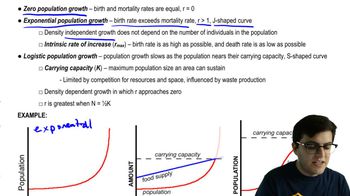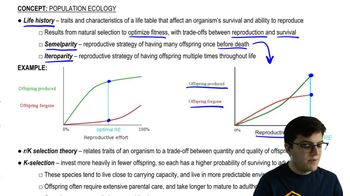Table of contents
- 1. Introduction to Biology2h 40m
- 2. Chemistry3h 40m
- 3. Water1h 26m
- 4. Biomolecules2h 23m
- 5. Cell Components2h 26m
- 6. The Membrane2h 31m
- 7. Energy and Metabolism2h 0m
- 8. Respiration2h 40m
- 9. Photosynthesis2h 49m
- 10. Cell Signaling59m
- 11. Cell Division2h 47m
- 12. Meiosis2h 0m
- 13. Mendelian Genetics4h 41m
- Introduction to Mendel's Experiments7m
- Genotype vs. Phenotype17m
- Punnett Squares13m
- Mendel's Experiments26m
- Mendel's Laws18m
- Monohybrid Crosses16m
- Test Crosses14m
- Dihybrid Crosses20m
- Punnett Square Probability26m
- Incomplete Dominance vs. Codominance20m
- Epistasis7m
- Non-Mendelian Genetics12m
- Pedigrees6m
- Autosomal Inheritance21m
- Sex-Linked Inheritance43m
- X-Inactivation9m
- 14. DNA Synthesis2h 27m
- 15. Gene Expression3h 20m
- 16. Regulation of Expression3h 31m
- Introduction to Regulation of Gene Expression13m
- Prokaryotic Gene Regulation via Operons27m
- The Lac Operon21m
- Glucose's Impact on Lac Operon25m
- The Trp Operon20m
- Review of the Lac Operon & Trp Operon11m
- Introduction to Eukaryotic Gene Regulation9m
- Eukaryotic Chromatin Modifications16m
- Eukaryotic Transcriptional Control22m
- Eukaryotic Post-Transcriptional Regulation28m
- Eukaryotic Post-Translational Regulation13m
- 17. Viruses37m
- 18. Biotechnology2h 58m
- 19. Genomics17m
- 20. Development1h 5m
- 21. Evolution3h 1m
- 22. Evolution of Populations3h 52m
- 23. Speciation1h 37m
- 24. History of Life on Earth2h 6m
- 25. Phylogeny2h 31m
- 26. Prokaryotes4h 59m
- 27. Protists1h 12m
- 28. Plants1h 22m
- 29. Fungi36m
- 30. Overview of Animals34m
- 31. Invertebrates1h 2m
- 32. Vertebrates50m
- 33. Plant Anatomy1h 3m
- 34. Vascular Plant Transport2m
- 35. Soil37m
- 36. Plant Reproduction47m
- 37. Plant Sensation and Response1h 9m
- 38. Animal Form and Function1h 19m
- 39. Digestive System10m
- 40. Circulatory System1h 57m
- 41. Immune System1h 12m
- 42. Osmoregulation and Excretion50m
- 43. Endocrine System4m
- 44. Animal Reproduction2m
- 45. Nervous System55m
- 46. Sensory Systems46m
- 47. Muscle Systems23m
- 48. Ecology3h 11m
- Introduction to Ecology20m
- Biogeography14m
- Earth's Climate Patterns50m
- Introduction to Terrestrial Biomes10m
- Terrestrial Biomes: Near Equator13m
- Terrestrial Biomes: Temperate Regions10m
- Terrestrial Biomes: Northern Regions15m
- Introduction to Aquatic Biomes27m
- Freshwater Aquatic Biomes14m
- Marine Aquatic Biomes13m
- 49. Animal Behavior28m
- 50. Population Ecology3h 41m
- Introduction to Population Ecology28m
- Population Sampling Methods23m
- Life History12m
- Population Demography17m
- Factors Limiting Population Growth14m
- Introduction to Population Growth Models22m
- Linear Population Growth6m
- Exponential Population Growth29m
- Logistic Population Growth32m
- r/K Selection10m
- The Human Population22m
- 51. Community Ecology2h 46m
- Introduction to Community Ecology2m
- Introduction to Community Interactions9m
- Community Interactions: Competition (-/-)38m
- Community Interactions: Exploitation (+/-)23m
- Community Interactions: Mutualism (+/+) & Commensalism (+/0)9m
- Community Structure35m
- Community Dynamics26m
- Geographic Impact on Communities21m
- 52. Ecosystems2h 36m
- 53. Conservation Biology24m
50. Population Ecology
Introduction to Population Ecology
Problem 8d
Textbook Question
Textbook QuestionIndicate what is correct and incorrect about this statement: If lizards want to survive during climate change, they can evolve new life-history traits.
 Verified step by step guidance
Verified step by step guidance1
Step 1: Understand the statement. The statement suggests that lizards can evolve new life-history traits to survive during climate change.
Step 2: Identify the correct part of the statement. It is true that organisms, including lizards, can evolve new traits over time in response to environmental changes. This is a fundamental concept in evolutionary biology.
Step 3: Identify the incorrect part of the statement. The incorrect part is the implication that lizards, or any organisms, can 'want' to evolve or consciously control their evolution. Evolution is a natural process driven by genetic variation and natural selection, not by the desires or intentions of organisms.
Step 4: Understand the concept of evolution. Evolution is a process that occurs over many generations, and it's not something that an individual organism can do during its lifetime. It's a population-level phenomenon.
Step 5: Understand the concept of life-history traits. Life-history traits are characteristics that affect an organism's schedule and manner of reproduction. These traits can evolve over time in response to environmental pressures, but again, this is not a process that individual organisms can consciously control.
Recommended similar problem, with video answer:
 Verified Solution
Verified SolutionThis video solution was recommended by our tutors as helpful for the problem above
Video duration:
1mPlay a video:
Was this helpful?
Key Concepts
Here are the essential concepts you must grasp in order to answer the question correctly.
Evolution
Evolution is the process through which species change over time through variations in traits that are passed down through generations. Natural selection plays a crucial role, as individuals with advantageous traits are more likely to survive and reproduce. However, evolution occurs over long timescales, making immediate adaptation to rapid environmental changes, like climate change, challenging.
Recommended video:

Introduction to Evolution of Populations
Life-history Traits
Life-history traits refer to the biological characteristics of an organism that influence its reproductive success and survival, such as age at first reproduction, number of offspring, and lifespan. These traits are shaped by evolutionary pressures and can vary significantly among species. Changes in life-history traits can be a response to environmental factors, but such changes typically require multiple generations.
Recommended video:
Guided course

Life History
Phenotypic Plasticity
Phenotypic plasticity is the ability of an organism to change its phenotype in response to environmental conditions. This adaptability allows species to survive in varying environments without genetic changes. For lizards facing climate change, phenotypic plasticity may enable them to adjust behaviors or physiological traits quickly, but it does not equate to evolutionary changes in life-history traits.
Recommended video:
Guided course

Phenotypic Plasticity

 1:17m
1:17mWatch next
Master Population Ecology with a bite sized video explanation from Jason Amores Sumpter
Start learningRelated Videos
Related Practice



































































